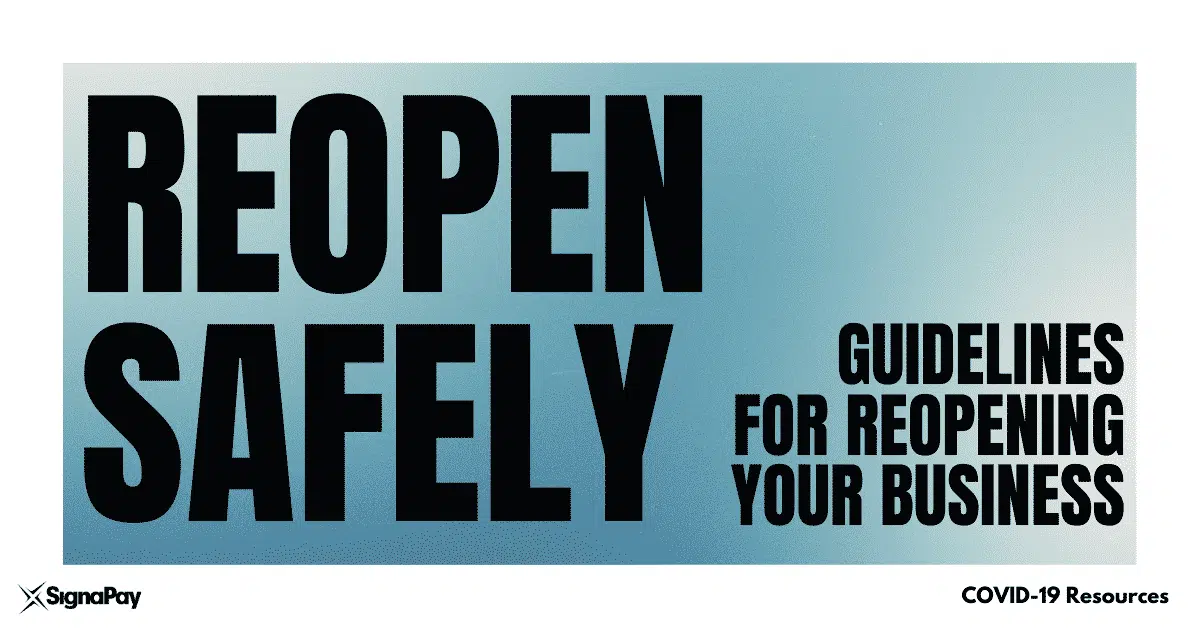Reopen Safely: Guidelines for reopening your business.

All 50 US States have begun to reopen after the COVID-19 shutdown and many businesses are eager to see full stores and heavy foot traffic. While it will take time for things to back to “business as usual” implementing some policies for your business to make customers feel safe to shop is a big step towards returning to normal business operations.
States across the country have their own guidelines for reopening, and we highly encourage you to find out what your states restrictions and rules are before reopening your doors.
If you have yet to reopen your doors after the shutdown, start planning now on how you want to do so. Read up on your state’s guidelines and the federal government’s recommendations on reopening. Look to the example of essential businesses and services that have remained open during the shutdown. Grocery stores, for example, have been running with capacity restrictions to limit contact between people, and have installed sneeze-guards at registers where markers are placed 6 feet apart to encourage social distancing.
Coronavirus is still spreading. It’s a reality we are living with now as part of daily life. Part of reopening responsibly is looking out for your employees: the people who will have most contact with customers filtering in and out of your place of business. We recommend health checks with your employees before, during and after their shifts to make sure they’re not exhibiting symptoms related to COVID-19. Some localities have mandated these checks along with temperature readings before an employee clocks in. Check with your local government for their guidelines on protecting your employees. You should be on the lookout for:
- Coughing, shortness of breath, sore throats, diarrhea or a fever.
- If employees have come into contact with somebody infected with COVID-19
- If employees have travelled domestically or internationally.
The CDC recommends your employees wear PPE such as wearing a cloth face covering or mask in all public settings to slow the spread. Wearing a mask significantly reduces the risk of transmission between someone who may be infected and not yet may be showing symptoms of the virus. Consider stocking up on PPE such as gloves and masks for your employees. Not only does it protect your employees, but also establishes a sense of safety and security for your customers that are returning to your place of business.
While you have taken care of your employees, consider to the group that you are reopening for: your customers. In some states and localities, you may need to abide by occupancy limits and other social distancing measures; such as restaurants being required to spread out tables 6 ft apart. Make hand sanitizer available near common touch surfaces, such as your card terminal or POS. Regularly cleaning these items and surfaces, sometimes multiple times a day, is recommended. Consider requiring your employees and customers wear masks while inside your store. In some settings, such as doctor’s offices, temperature checks are recommended at the door before allowing people in. Bear in mind, temperature checks are required to comply with health care privacy laws. Make sure you implement a system that protects the privacy of those you check.
Recent blog posts
The latest industry news, interviews, technologies, and resources
Strategies for Improving Cost Control and Expense Control
Boosting Your Bottom Line: Strategies for Improving Cost and Expense Control In the fast-paced world of business, keeping a tight grip on costs and expenses is essential for maintaining profitability …
No-Fee Payment Processing: What Businesses Need to Know
No Fee Payment Processing: Understanding Surcharging, Cash Discounts, and Dual Pricing Credit card transactions offer convenient payment options for consumers but often come with fees that can burden businesses. Fortunately, …
Understanding PCI Compliance: Safeguarding Your Business
Discover the essential role of PCI compliance in safeguarding sensitive payment information in today’s digital landscape. Learn about the Payment Card Industry Data Security Standard (PCI DSS) and its stringent requirements for protecting cardholder data across online, in-store, and mobile payment channels. Explore the impact of PCI compliance on data security, operational efficiency, and customer trust. Discover how adherence to PCI standards can mitigate financial risks such as regulatory fines and reputational damage, while enhancing long-term business sustainability. Explore more about PCI compliance and secure your business’s future today.